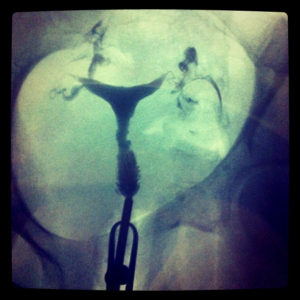One of the villains of female infertility are blocked or adherent fallopian tubes. Do you know what role the fallopian tube plays in pregnancy? The tube or uterine tube is a thin and delicate organ connected to the uterus that looks like little arms. And it is the tubes that capture the egg at the moment of ovulation. The tube houses the egg until the sperm reaches it to fertilize, taking the first step toward pregnancy1. In this sense, being certain of or predicting the day of ovulation is also very important to increase the chances of conception.

What Is a Blocked Tube?
This may be the main reason a couple cannot get pregnant and requires treatment. Blocked tubes can happen for various reasons2. One of them is an infection caused by bacteria or even sexually transmitted diseases like chlamydia, for example, which create a colony of fluids and mass inside the tubes, causing blockage. One of the main villains causing blocked tubes is endometriosis. The leakage of blood from inside the uterus can cause a blockage of the tubes. Tube adhesions are another cause and, most of the time, result from scarring in the tubes, usually after some surgery, childbirth, or removal of a tubal pregnancy.
Symptoms of Blocked Tubes and Adhesions
The most common symptom of blocked tubes is being unable to get pregnant. In rare cases, this blockage causes pain or discomfort. Most women who are trying to conceive should suspect blocked tubes if they haven’t become pregnant after more than a year. The doctor will request tests for diagnosis and, if blocked tubes are identified, the best and most suitable treatment will be recommended.
How to Diagnose
The way to know if the tubes are blocked and diagnose adhesion is called hysterosalpingography. In this test, a quantity of contrast is injected into the woman’s vaginal cavity, filling the inside of the uterus for a simple X-ray. In hysterosalpingography3, it is possible to be completely sure if there are blocked tubes or tubes with adhesions. Hysterosalpingography also checks for other problems like uterine fibroids or polyps that could hinder pregnancy.
Tube Unblocking Video
Video of a surgery by videolaparoscopy for unblocking the tubes. These are SURGERY scenes, so use caution when playing.
Treatments
What to do when the tubes are blocked? If there are adhesions or the tubes are completely blocked, the doctor will indicate the best procedure, which can range from surgery to unblock, to procedures like in vitro fertilization. Surgery for blocked tubes can be of two types: the traditional, like a cesarean, or, more commonly today, by laparoscopic method, which has better recovery. The masses obstructing the tubes can be completely removed in these procedures, thus allowing pregnancy to happen naturally. More severe cases, like hydrosalpinx, for example, may require more invasive treatments or even a direct indication for artificial forms of fertilization. Of course, always with medical guidance, and if there is a need to seek more opinions, the patient should feel free to do so. A basic requirement for women trying to get pregnant for over a year is to request a hysterosalpingography from their trusted doctor. The investigation should be done with the couple, not just the woman, so if there is any problem, it can be diagnosed more quickly. See also: Tubal Ligation Reversal – Is It Possible?












